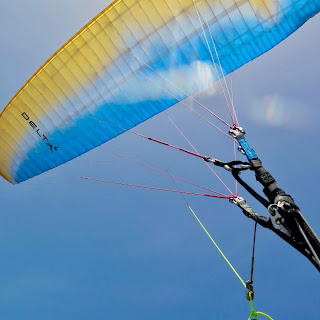
Pic: Ozone Delta 4 ziad bassil
OZONE Delta 4 ML and MS
And here’s the new EN-C from Ozone.I had two Delta 4 for testing. An ML that I flew at 101, with lots of ballast, and two pizzas, the MS size at 92 all up with just one ‘croissant’;-).

Pic: Ozone Delta 4 ziad bassil
Launching the ML and MS at their respective weights is pretty direct. Probably it rises slightly less than the D3, but nothing worth mentioning. No hardpoints, no surge, just an easy to launch C.
Usually, I fly smaller sizes, and when I fly the bigger ones or the Medium ones, I feel that they are too dampened compared to their little sisters…In-flight on the ML size, on a strong and turbulent day, my flying buddies were all over the place with hands going down and up, and wings getting tossed around, and I thought I was just sitting alone among that chaos, sipping a cup of tea!Really…the Delta 4 in ML size at 101- 102 is super comfy to my taste! Not boring at all but solid, smooth, and super homogenous.
The gliders that were around, were the Cure 2 M (75-95), the Flow Fusion M (85-105), and later the LM7, MS (75-95), and some other B’s. They seem to be doing some sports workout!
Anyway, the brake authority on that ML size at my loads are super nice! I was amazed that this ML size would turn quite nicely! Used to feel that bigger sizes feel like bigger ships to turn, but no, that Delta 4 ML has a very nice coordinated and smooth turn, with very good agility. The climb rate is really impressive on the ML!After many times, I felt that I had an edge over all the mentioned gliders in the air!In weak, and especially in sudden thermals. The D4 shoots upward quickly.
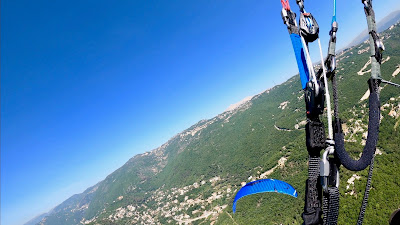
Pic: Ozone Delta 4 ziad bassil
Doing some glides with the Cure 2 M, at trim, showed me after many attempts that theD4 ML has an edge at trim and a large edge at full bar!Gliding next to the Fusion Mshowed that the Fusion had a slightly faster trim speed, but when matching the Fusion trim speed, again, I felt that I had an edge at trim, and a large one at full bar!
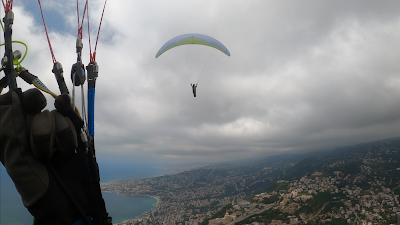
Pic: Ozone Delta 4 ziad bassil
So it was preferable to see that ML size with the LM7 MS.My friend flying the MS is a good pilot, and we glided over 10 KM, three times, with him pushing the bar all the time. On the Delta 4 ML, I could always be on his wingtip, with a slight edge for the Delta 4 ML in lifts!
It was very impressive to see that easy to flyD4 ML (6) aspect ratio, EN-C,at full bar has nearly or similar glide angle as the LM7 size MS!Many climbs and glides were made with the same results. I know the LM7 was a size smaller than the D4 ML. It was only to give an idea about the overall performance.
Ears are stable a bit if you don’t pull much. They lock if you pull them once slightly. Just like the Mantra 7 ones. Not really super-efficient, but ok.
Three days later, I received the Delta 4 MS size (75-95).
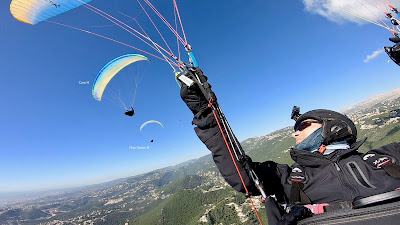
Pic: Ozone Delta 4 ziad bassil
Launching the Delta 4 MS, at 93 all up in very dry and turbulent air, showed me that there is a large difference in roll feedback with the bigger size. I couldn’t get a cup of tea, but able to talk on the phone ? . The roll movements are more present than the ML size, the pitch movement is still very stable.
My friend on his Cure 2 M commented that the air was super rowdy and barely acceptable. The D4 MS was quite manageable with a high degree of comfort.The structure is very homogenous and solid, especially(if it is well loaded! ) 93 all up was ok.
The handling and brake authority are much better to my liking now. The Delta 4 MS at 93 is an agile glider.I could place it in that turbulent air exactly where I wanted after getting hammered with some instant powerful thermals that lasts two seconds…Getting through and inside those nasty narrow lifts was possible on the D4 MS.
Now comparing with the same sizes as the D4 MS ( 75-95).
Climbing next to my friend on his Cure 2 M (75-95), with the same loadings as mine now, showed me that in strong air and powerful thermals, the D4 climbs upward again, quite rapidly! At the end of that day, when thermals were very weak, they both could float next to each other, and it was super difficult to tell if either climbs better or float better. Anyway, my C comparison will be updated for those tiny details if needed.
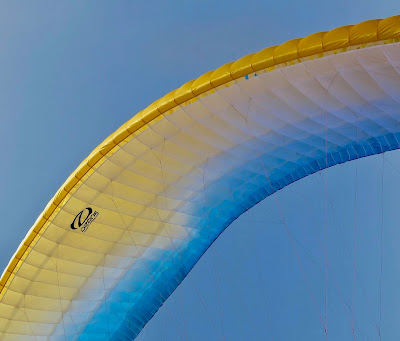
Pic: Ozone Delta 4 ziad bassil
Doing some long glides next to the same Cure 2 M, (they have the same trim speed), showed me now that the D4 MS size has a slight edge in glide at trim and the difference is smaller than I got on the ML size.
For instance, the difference at trim after a 5 km run is only around 5 m difference for the Delta 4 MS, but when we applied full bar, the difference became bigger for the Delta 4.
The D4, MS has a good edge and an impressive glide angle at full speed.Now at full speed for both, and overlapping the pulleys on the D4, I was getting slightly faster top speed. Probably around +1 km/h…
Comparing the M7 size MS to the Delta 4 size MS is really interesting. The gap is super small! Like perhaps the edge for the M7 is found when low facing the sea breeze and getting those tricky thermals, the M7 will have a slight edge in surfing through the airmass. Saying that the Delta 4 in that particular difficult place with shine flawlessly among C’s. It cuts through like the M7 but slightly slower and tamer. It will take its time to dig through calmly. Ozone has strongly narrowed the gap between the Rush5, Delta 4, Mantra7!
Racing the Delta 4 at full speed in turbulent air, and steering with the C risers is quite efficient, as I was able to clear most of the pitch and roll by the smooth and easy to steer C risers.Like I said, with that easiness in flight, and performance at speed, the Delta 4 will give the pilots a clear edge in sports competitions. The C riser controls have a moderate pressure and linear response, with very good authority on the profile.

Ears’ behavior is similar to the ML size. If you pull a lot, they will try to re-open,A little pull will get them stuck and stable, with a moderate decent rate. Wing overs are a delight! Get quickly upside down!
Conclusion:
I was super lucky after the corona lockdown to test fly some amazing gliders.
I also have to add that the Delta 4 MS has a more subtle feel, and a little bit more communicative than the Delta 3 MS in showing and sensing a little bit more the airmass. That characteristic is enhanced over the D3 and it’s a good move from the R&D department.
For the C category, what impresses me the most is when a manufacturer works on a moderate aspect ratio glider, like 6.05 for the Delta 4 and achieves an impressively complete package of feel-able passive safety, high comfort in turbulence, superb agility, with a pleasurable feel,top-end gliding performance and fast enough for the C category!
I’ll keep those new gliders coming through to see what could be more possible, and will keep one Delta 4 MS size as the new C reference.
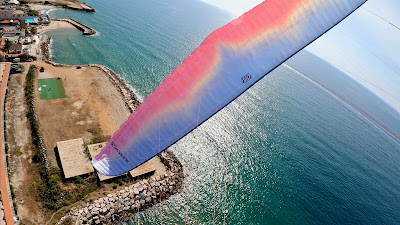
Comparing the same sizes:Mantra 7 MSVSDelta 4 MS, will give a tiny edge for overall performance to the M7, but I think Mantra 7 pilots must watch out carefully, Delta 4 pilots on full bar !! 😉
 Ears’ behavior is similar to the ML size. If you pull a lot, they will try to re-open,A little pull will get them stuck and stable, with a moderate decent rate. Wing overs are a delight! Get quickly upside down!
Ears’ behavior is similar to the ML size. If you pull a lot, they will try to re-open,A little pull will get them stuck and stable, with a moderate decent rate. Wing overs are a delight! Get quickly upside down!













